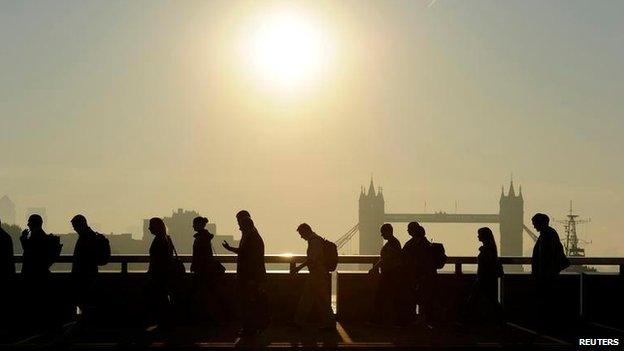Squeeze ends for the long-term employed
- Published
- comments

This year's annual survey of hours and earnings is a treasure chest of seeming paradoxes. And gosh, I am so excited.
So the headline, according to the Office for National Statistics, is that median gross weekly earnings for those in full-time work rose by a solitary quid or just 0.1% to £518 in the year to April 2014.
This is the smallest increase in what a typical person is paid since 1997 (the median is supposed to represent Joe Every-Person - or the individual bang in the middle of the spectrum).
And adjusting for inflation, "real" earnings therefore fell 1.6% - and have fallen every year since the 2008 crash, back to the levels of the turn of the millennium.
Bloomin' 'eck the banking crisis and Great Recession did some damage (to tell you what you already know).
But hang on a moment - is that a light at the end of the tunnel that might not be a juggernaut driven by the devil out to flatten us?
Well it might just be. Because those in a job for more than a year saw their weekly earnings rise considerably more than inflation at 4.1%.
In other words most of the earnings squeeze is what economists (curse them) call a compositional effect - it is caused by those entering the work force or changing jobs getting lower pay rates than those in steady employment.
You could see this, in part, as the UKIP factor, or immigrants coming here and working for less than the indigenous workforce.
But it is probably more to do with the desperation of the unemployed to get a foot on the jobs ladder, however low down the pay rung that job may be.
Either way, after years of falling living standards, it is surely encouraging to see that it is not a magical story from a faraway land that wages can actually rise for those in work for a while.
Gender pay gap narrows
Nor is this the only riveting tale to be told.
The survey also shows that the pay gap between men and women is at its lowest, 9.4%, since these records began in 1997.
And what is really important is that the typical woman actually earns more than the typical man (Jo Bloggs versus Joe Bloggs) between the age of 22 and 40.
It is when women leave work for a while, to look after infants, that their career prospects and earning power are hammered.
And, by the way, the gender pay gap is three times bigger for highest paid and highest skilled jobs than for low-skilled, low-pay jobs - though believe it or not, earnings distribution for the boss class has become the least sexist on record (it is still horribly sexist - the top 10% of male earners pocket 18.3% more than the top 10% of women earners).
One more thing. The earnings gap between the top 10% of earners and bottom 10% has remained perhaps surprisingly steady over the 17 years of this assessment: the decile at the top has consistently been paid 3.5 times what the bottom decile is paid.
So on this one narrow measure, inequality has not worsened. But there are lots of other measures which offer a different, less egalitarian narrative.